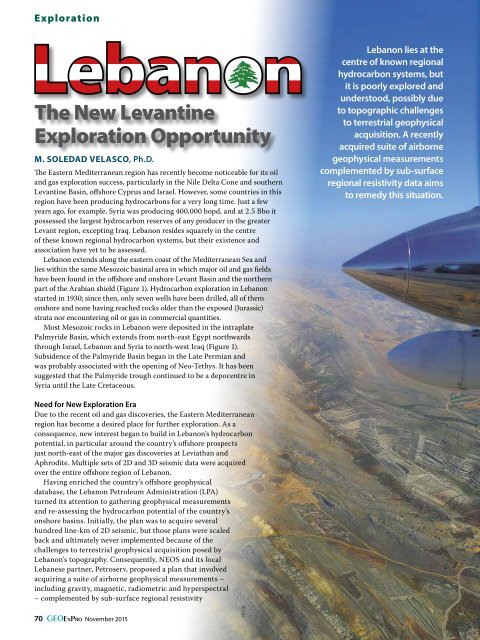Iraqi Kurdistan All in the Timing
GEO_ExPro_v12i6
GEO_ExPro_v12i6
You also want an ePaper? Increase the reach of your titles
YUMPU automatically turns print PDFs into web optimized ePapers that Google loves.
Exploration<br />
The New Levant<strong>in</strong>e<br />
Exploration Opportunity<br />
M. SOLEDAD VELASCO, Ph.D.<br />
The Eastern Mediterranean region has recently become noticeable for its oil<br />
and gas exploration success, particularly <strong>in</strong> <strong>the</strong> Nile Delta Cone and sou<strong>the</strong>rn<br />
Levant<strong>in</strong>e Bas<strong>in</strong>, offshore Cyprus and Israel. However, some countries <strong>in</strong> this<br />
region have been produc<strong>in</strong>g hydrocarbons for a very long time. Just a few<br />
years ago, for example, Syria was produc<strong>in</strong>g 400,000 bopd, and at 2.5 Bbo it<br />
possessed <strong>the</strong> largest hydrocarbon reserves of any producer <strong>in</strong> <strong>the</strong> greater<br />
Levant region, except<strong>in</strong>g Iraq. Lebanon resides squarely <strong>in</strong> <strong>the</strong> centre<br />
of <strong>the</strong>se known regional hydrocarbon systems, but <strong>the</strong>ir existence and<br />
association have yet to be assessed.<br />
Lebanon extends along <strong>the</strong> eastern coast of <strong>the</strong> Mediterranean Sea and<br />
lies with<strong>in</strong> <strong>the</strong> same Mesozoic bas<strong>in</strong>al area <strong>in</strong> which major oil and gas fields<br />
have been found <strong>in</strong> <strong>the</strong> offshore and onshore Levant Bas<strong>in</strong> and <strong>the</strong> nor<strong>the</strong>rn<br />
part of <strong>the</strong> Arabian shield (Figure 1). Hydrocarbon exploration <strong>in</strong> Lebanon<br />
started <strong>in</strong> 1930; s<strong>in</strong>ce <strong>the</strong>n, only seven wells have been drilled, all of <strong>the</strong>m<br />
onshore and none hav<strong>in</strong>g reached rocks older than <strong>the</strong> exposed (Jurassic)<br />
strata nor encounter<strong>in</strong>g oil or gas <strong>in</strong> commercial quantities.<br />
Most Mesozoic rocks <strong>in</strong> Lebanon were deposited <strong>in</strong> <strong>the</strong> <strong>in</strong>traplate<br />
Palmyride Bas<strong>in</strong>, which extends from north-east Egypt northwards<br />
through Israel, Lebanon and Syria to north-west Iraq (Figure 1).<br />
Subsidence of <strong>the</strong> Palmyride Bas<strong>in</strong> began <strong>in</strong> <strong>the</strong> Late Permian and<br />
was probably associated with <strong>the</strong> open<strong>in</strong>g of Neo-Tethys. It has been<br />
suggested that <strong>the</strong> Palmyride trough cont<strong>in</strong>ued to be a depocentre <strong>in</strong><br />
Syria until <strong>the</strong> Late Cretaceous.<br />
Lebanon lies at <strong>the</strong><br />
centre of known regional<br />
hydrocarbon systems, but<br />
it is poorly explored and<br />
understood, possibly due<br />
to topographic challenges<br />
to terrestrial geophysical<br />
acquisition. A recently<br />
acquired suite of airborne<br />
geophysical measurements<br />
complemented by sub-surface<br />
regional resistivity data aims<br />
to remedy this situation.<br />
Need for New Exploration Era<br />
Due to <strong>the</strong> recent oil and gas discoveries, <strong>the</strong> Eastern Mediterranean<br />
region has become a desired place for fur<strong>the</strong>r exploration. As a<br />
consequence, new <strong>in</strong>terest began to build <strong>in</strong> Lebanon’s hydrocarbon<br />
potential, <strong>in</strong> particular around <strong>the</strong> country’s offshore prospects<br />
just north-east of <strong>the</strong> major gas discoveries at Leviathan and<br />
Aphrodite. Multiple sets of 2D and 3D seismic data were acquired<br />
over <strong>the</strong> entire offshore region of Lebanon.<br />
Hav<strong>in</strong>g enriched <strong>the</strong> country’s offshore geophysical<br />
database, <strong>the</strong> Lebanon Petroleum Adm<strong>in</strong>istration (LPA)<br />
turned its attention to ga<strong>the</strong>r<strong>in</strong>g geophysical measurements<br />
and re-assess<strong>in</strong>g <strong>the</strong> hydrocarbon potential of <strong>the</strong> country’s<br />
onshore bas<strong>in</strong>s. Initially, <strong>the</strong> plan was to acquire several<br />
hundred l<strong>in</strong>e-km of 2D seismic, but those plans were scaled<br />
back and ultimately never implemented because of <strong>the</strong><br />
challenges to terrestrial geophysical acquisition posed by<br />
Lebanon’s topography. Consequently, NEOS and its local<br />
Lebanese partner, Petroserv, proposed a plan that <strong>in</strong>volved<br />
acquir<strong>in</strong>g a suite of airborne geophysical measurements –<br />
<strong>in</strong>clud<strong>in</strong>g gravity, magnetic, radiometric and hyperspectral<br />
– complemented by sub-surface regional resistivity<br />
70 GEOExPro November 2015<br />
NEOS


